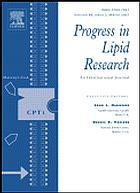|
Literature / Source Database:
Progress in Lipid Research
Description
An International Journal
| Title (short) |
Prog. Lipid Res. |
| Languages |
English |
| First year |
1952 |
| Impact factor |
11.238 |
| Editor |
Howard Sprecher, John L. Harwood, Dennis R. Voelker, Masahiro Nishijima |
|
|

|
Status
active
Indexing
BIOMED; BIOSIS; Chemical Abstracts; Current Contents/Agriculture, Biology & Environmental Sciences; Current Contents/Life Sciences; EMBASE;
EMBiology; Elsevier BIOBASE; Index to Scientific Reviews; MEDLINE®; Research Alert; SCISEARCH; Science Citation Index; Scopus
Predecessor
Progress in the Chemistry of Fats and other Lipids
Subject

Source type
Journal
Publisher
ISBN ISSN
0163-7827
First volume
18
Last volume
47+
Homepage
| Resources |
|
Availability |
|
|
|
|
|
| Text PDF |
 |
free access |
 |
| Text Html |
 |
for subscriber |
 |
| References |
 |
not available |
 |
| Abstracts |
 |
|
|
| TOC |
 |
|
|
|
|
|
|

Description
The importance of lipids as one of the fundamental classes of biological compounds is well established. The application of our knowledge of the biochemistry, chemistry and physiology of lipids to biotechnology, the fats and oils industry and medicine have continued to expand apace. In addition new dimensions such as lipid biophysics, especially with relevance to membranes and lipoproteins, and basic liposome research and applications have been added. To cope with all these advances in knowledge a journal is needed to review recent progress in particular fields and to set current research against its historical background. Progress in Lipid Research fulfils this role.
Each volume contains up-to-date surveys of special aspects of lipid research. The reviews are comprehensive enough to provide sufficient overview but concentrate on reporting and critically appraising the most recent data. Subjects are chosen for their timeliness or because major developments have taken place in the last few years. They include methodological reviews as well as chemical, biochemical and medical articles. All lipid compounds and derivatives are covered, ranging from fatty acids and other simple molecules, through steroids, terpenoids and phospho- or glycolipids to complex structures such as lipoproteins and biological membranes. We hope that those whose main interest is in lipid biophysics and liposome research will join as new readers, benefiting from the journal's classical aspects of lipid metabolism, lipids in signal transduction and lipid enzymology, and that current readers will benefit from the exposure to top quality research on the new aspects.
|